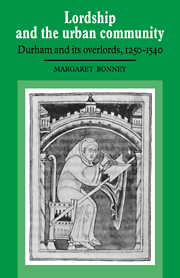Book contents
- Frontmatter
- Contents
- Acknowledgements
- List of abbreviations
- INTRODUCTION
- 1 URBAN ORIGINS: THE GROWTH AND DEVELOPMENT OF DURHAM TO 1250
- 2 THE URBAN LANDSCAPE OF DURHAM 1250–1540
- 3 DURHAM'S MEDIEVAL BUILDINGS
- 4 LANDLORD AND TENANTS: THE ECONOMIC RELATIONSHIP BETWEEN DURHAM PRIORY AND ITS URBAN TENANTS IN THE LATER MIDDLE AGES
- 5 TRADES AND OCCUPATIONS
- 6 LORDSHIP IN ACTION: THE MAINTENANCE OF LAW AND ORDER IN LATE-MEDIEVAL DURHAM
- CONCLUSION: LORDSHIP AND COMMUNITY: THE RELATIONS BETWEEN DURHAM AND ITS ECCLESIASTICAL OVERLORDS IN THE LATER MIDDLE AGES
- Appendix 1 Maps and plans of Durham
- Appendix 2 Tables
- Appendix 3 The dates of the bishops of Durham from 995 to the Dissolution
- Appendix 4 The obedientiaries of Durham Priory
- Appendix 5 The Durham courts
- Bibliography
- Index
2 - THE URBAN LANDSCAPE OF DURHAM 1250–1540
Published online by Cambridge University Press: 06 January 2010
- Frontmatter
- Contents
- Acknowledgements
- List of abbreviations
- INTRODUCTION
- 1 URBAN ORIGINS: THE GROWTH AND DEVELOPMENT OF DURHAM TO 1250
- 2 THE URBAN LANDSCAPE OF DURHAM 1250–1540
- 3 DURHAM'S MEDIEVAL BUILDINGS
- 4 LANDLORD AND TENANTS: THE ECONOMIC RELATIONSHIP BETWEEN DURHAM PRIORY AND ITS URBAN TENANTS IN THE LATER MIDDLE AGES
- 5 TRADES AND OCCUPATIONS
- 6 LORDSHIP IN ACTION: THE MAINTENANCE OF LAW AND ORDER IN LATE-MEDIEVAL DURHAM
- CONCLUSION: LORDSHIP AND COMMUNITY: THE RELATIONS BETWEEN DURHAM AND ITS ECCLESIASTICAL OVERLORDS IN THE LATER MIDDLE AGES
- Appendix 1 Maps and plans of Durham
- Appendix 2 Tables
- Appendix 3 The dates of the bishops of Durham from 995 to the Dissolution
- Appendix 4 The obedientiaries of Durham Priory
- Appendix 5 The Durham courts
- Bibliography
- Index
Summary
The city of Durham is in a region which has as its natural boundaries the River Tyne and its valley to the north and the River Tees to the south. The landscape ranges from bleak moorland areas and the Pennine chain, rising to over 2,400 feet, on the west to a coastal plain on the east which lies at sea level. Although this region was described by medieval chroniclers as impoverished border country, it had many natural resources which could be exploited by its inhabitants. It was an area rich in mineral deposits such as lead, which was mined in Weardale in the middle ages. The bishop of Durham held some of the most valuable coal mines in medieval England at Gateshead and Whickham. The gently rolling countryside to the south-east of Durham was farmed by the monks of Durham Priory for its grain. There was cattle farming in the north of the region, with sheep grazing on the higher land to the west. Surplus agricultural produce was brought to the market towns of the area including Durham, Darlington and Stockton, and goods were shipped in and out of the region from the ports of Gateshead and Hartlepool. Furthermore, there was a network of small agricultural settlements, particularly in the east lowland areas of the county, like Boldon, Pittington, Easington and Billingham. Accordingly, Durham was surrounded by a relatively rich and varied hinterland.
The town itself stands in a lowland area some fifteen miles from the coast, an area which is by no means lacking in visual and geological interest.
- Type
- Chapter
- Information
- Lordship and the Urban CommunityDurham and its Overlords, 1250–1540, pp. 37 - 74Publisher: Cambridge University PressPrint publication year: 1990



